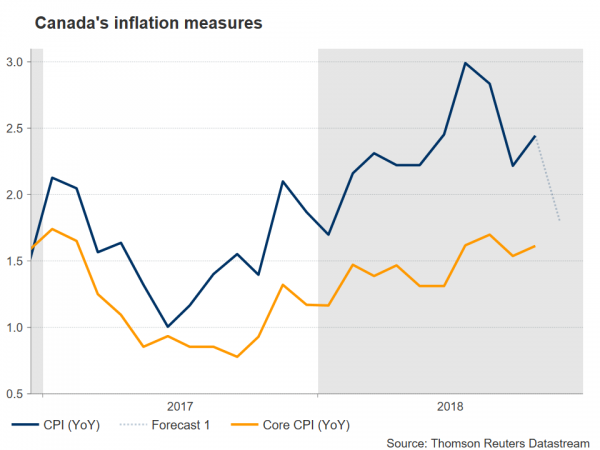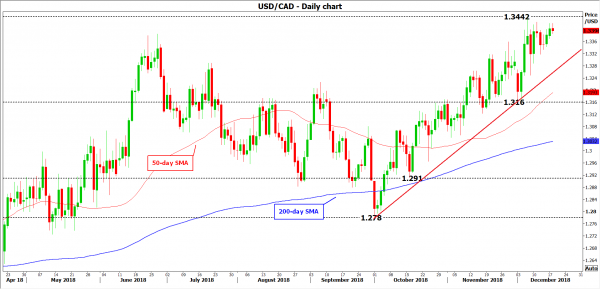Canadian inflation figures will hit the markets on Wednesday at 1330 GMT as well as retail sales and GDP numbers that are scheduled to be released on Friday at 1330 GMT. On December 5, the Bank of Canada (BOC) left its benchmark interest rate unchanged at 1.75%, after raising it by 25bps in the preceding meeting as was widely expected. It remained the highest rate since December 2008. Policymakers mentioned that more interest rate hikes will be needed to keep inflation into a range of 2% target and that will depend on several factors, which include consumption and housing, global trade policy developments, oil prices and the Bank’s assessment of the economy’s spare capacity.
The nation’s inflation as gauged by the Consumer Price Index (CPI) is expected to have increased by 1.8% on an annual basis in November versus 2.4% in the previous month. Underlying measures of inflation – the common, median and trim CPIs, which are watched closely by the Bank of Canada – will also come out at the same time. Moreover, retail sales are forecast to have grown by 0.4% m/m in October, accelerating from the 0.2% rate in September. Excluding automobiles and parts that tend to be highly volatile, core retail sales are expected to have jumped by 0.2% m/m, from 0.1% m/m previously. Canada’s economy is forecasted to have grown by 0.2% in October, on a monthly basis, picking up some steam after a negative reading of 0.1% before.
Inflation numbers have the potential to shed some light, despite the confusion with regards to the BOC’s future plans. The slide in the headline CPI may be owed to the decrease in oil prices, but if this is accompanied by a decline in the core rate as well, investors may be convinced that the Bank will refrain from acting anytime in the first half of 2019. On the other hand, an upside surprise in this data set could encourage them to add to their bets of a rate hike early next year.
At its last meeting, the Bank left rates steady, however, the statement had a dovish tone compared to the hawkish one in the previous time, prompting market participants to take their January rate-hike bets off the table. More recently, BOC Governor, Stephen Poloz sounded even more dovish, saying rate hikes “can be interrupted” in an interview with CTV on Monday.
That said, Canada’s record employment numbers for November may have increase some hopes that officials could eventually push the hiking button at one of their upcoming gatherings. Canada’s manufacturing PMI touched a three-month high, driven by a record rise in surveyed employment, while the headline seasonally adjusted IHS Markit Manufacturing Purchasing Managers’ Index (PMI) jumped to 54.9 in November, up from 53.9 in October, to signal the sharpest improvement in business conditions since August.
It has been a rough one-and-a-half months for the Canadian dollar. The currency has been under pressure since the beginning of October, losing more than 4% versus the US dollar during this time. Weak oil prices and a cooling US economy have dampened Canada’s growth momentum, and the BOC responded by remaining on the sidelines and maintaining interest rates steady.
Stronger figures than expected would endorse further the scenario for a January or March rate increase and could help the loonie to recover somewhat. Having a look at dollar/loonie, in the daily timeframe, a downside movement could send prices towards the ascending trend line, around 1.3300, drawn from the lows of October 1. A penetration of this line could open the door for the 1.3160 support level, which holds beneath the 50-day simple moving average (SMA).
On the other side, a disappointing set of data could bring the Canadian dollar under renewed selling pressure. So, dollar/loonie could head even higher, challenging once again the 18-month high of 1.3443, achieved on December 6. An upside break could send prices towards the 1.3540 resistance, identified by the highs on June 2017.
Overall, besides monetary policy considerations, the domestic currency is affected from the performance of the oil market as Canada is a major oil producing country.
















